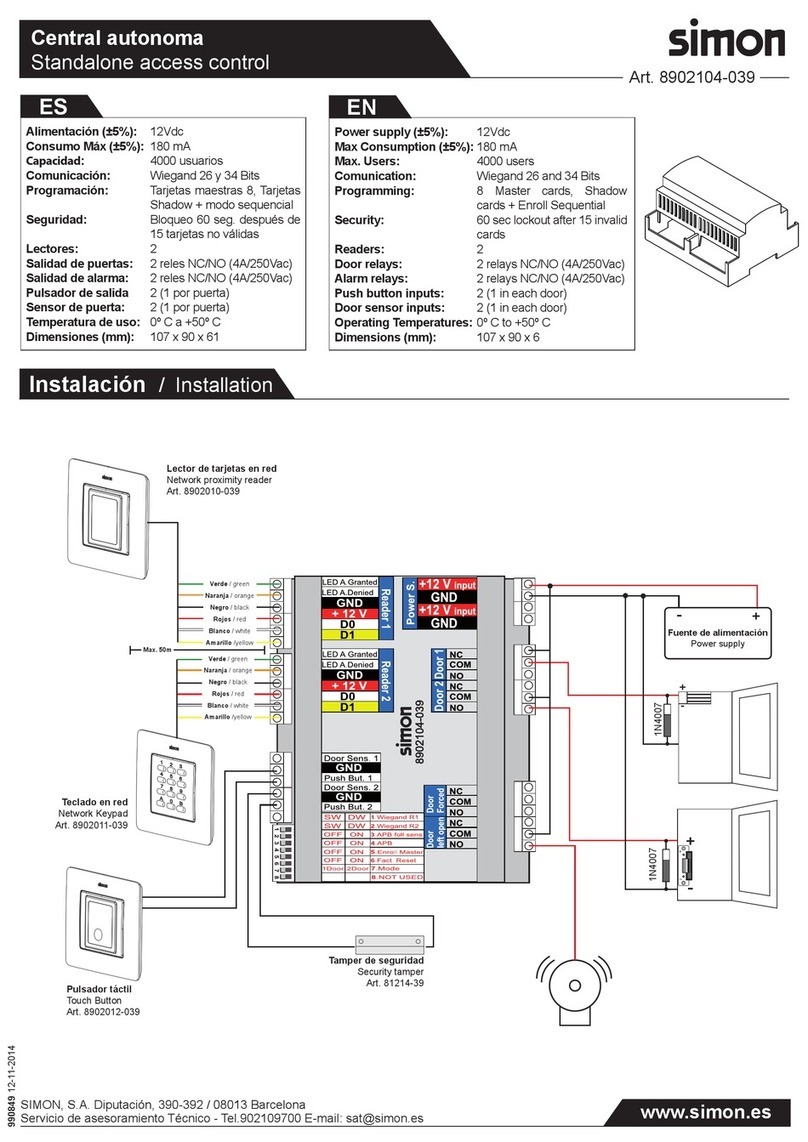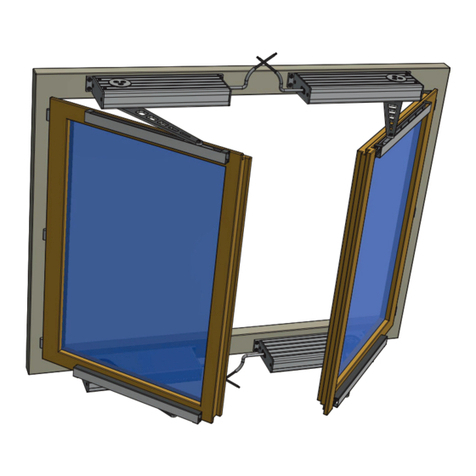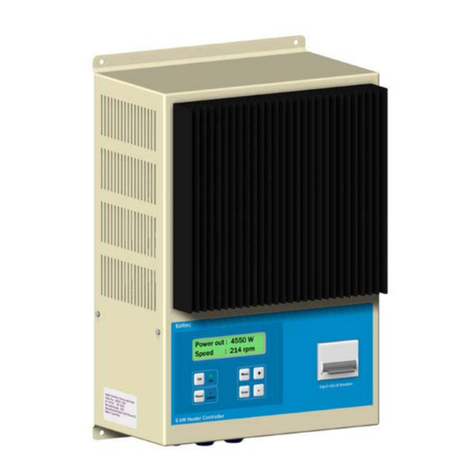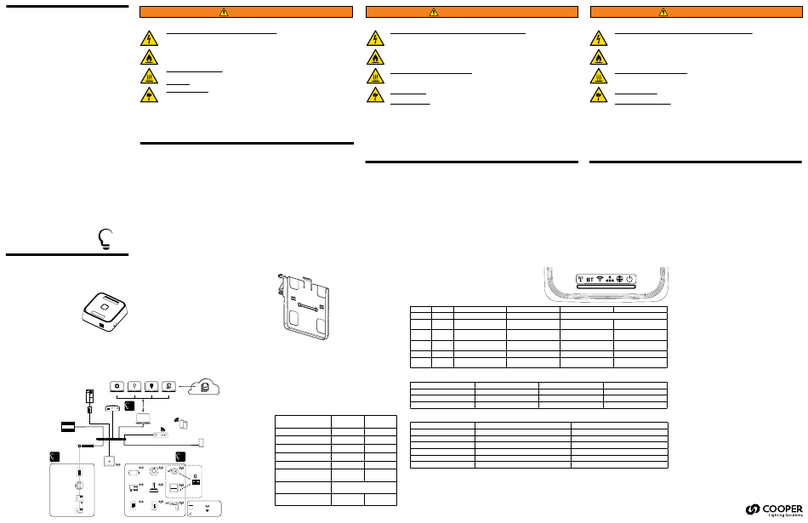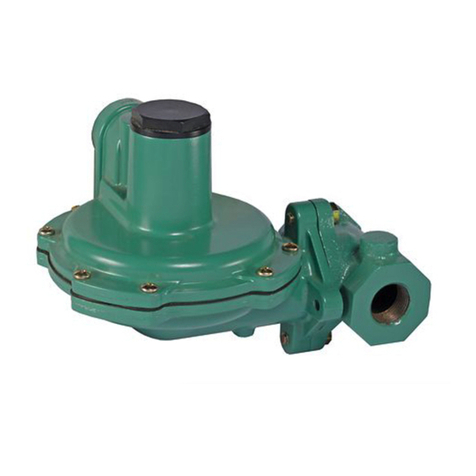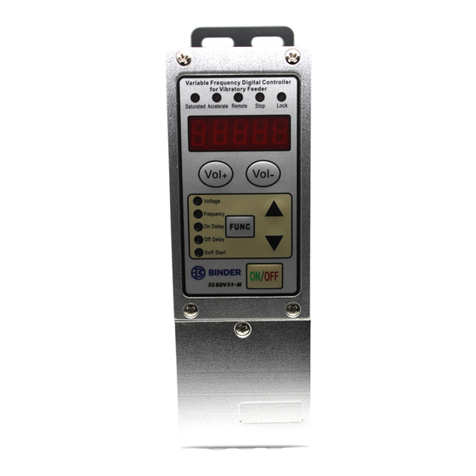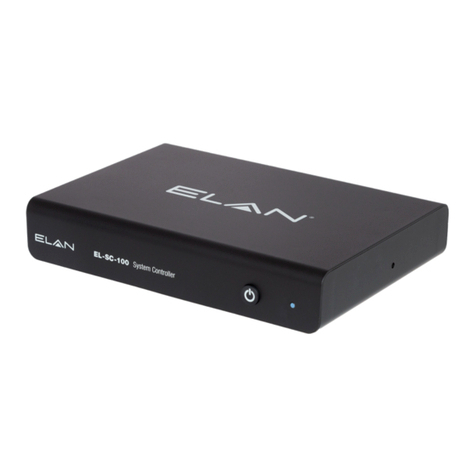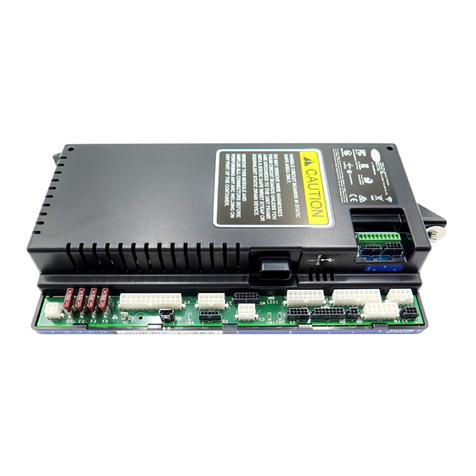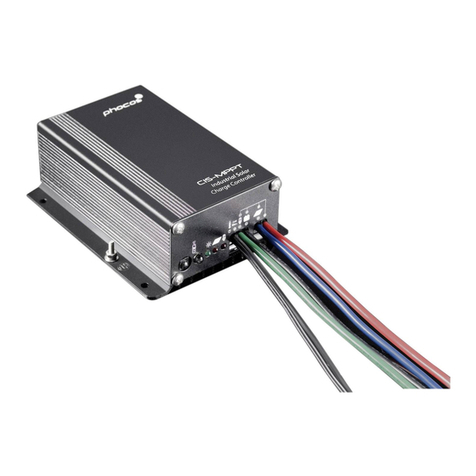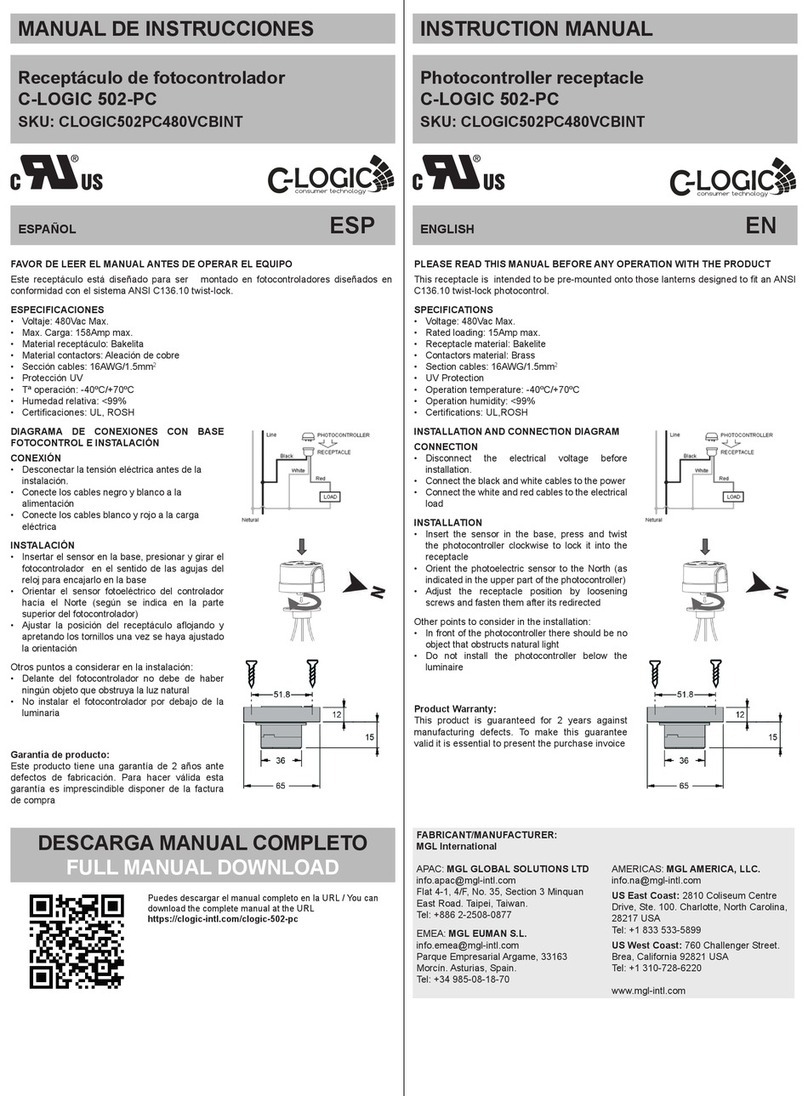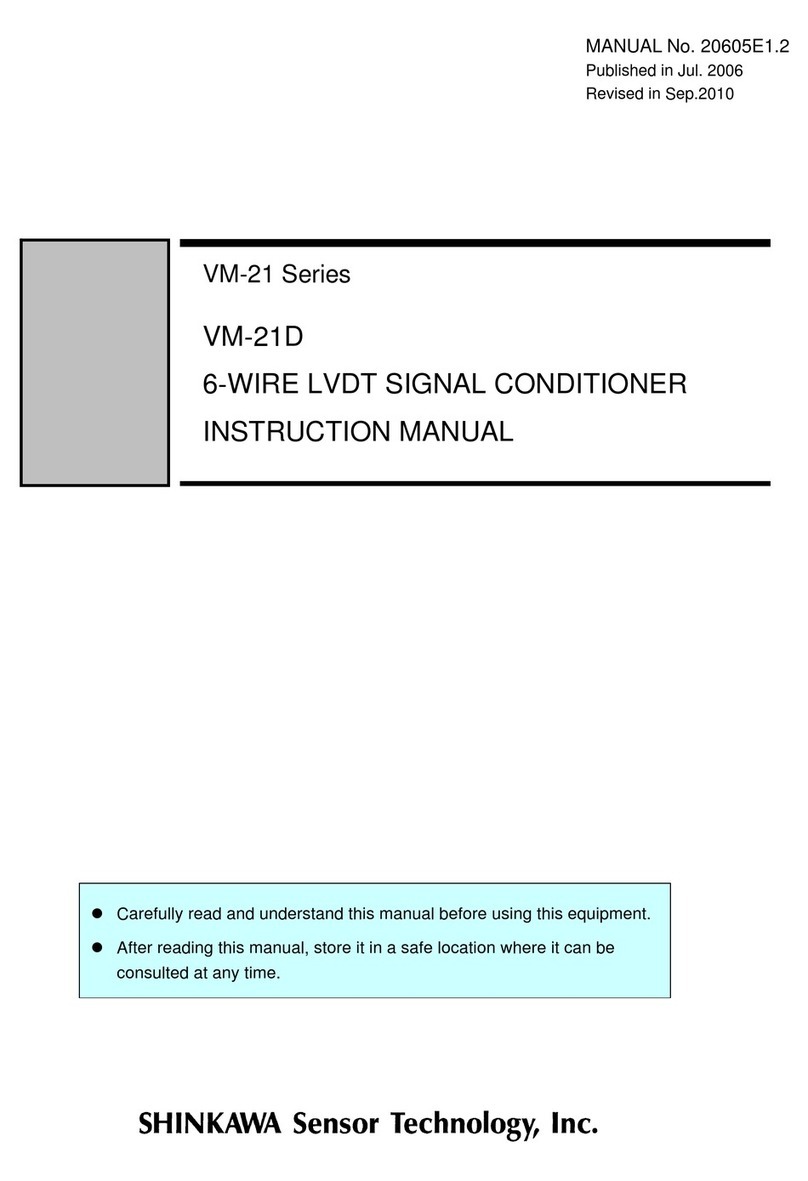Simon EA-K-30 Series User manual

BA_EA(230)-K-30-xxx_EN_12 www.simon-protec.com Date: 13.02.2019
BA EA-K-30/xxx-T(-DA) / EA230-K-30/xxx(-S) EN 1.2
Operating Manual
Chain actuator – EA-K-30/xxx-T(-DA)
Chain actuator – EA230-K-30/xxx(-S)
Copyright by SIMON PROtec Systems GmbH
Subject to technical changes and errors. All figures are exemplary.
Only valid with the supplementary sheet: “Safety Instructions and Warranty Conditions”!
Operating ManualValid for the following article numbers:
EA-K-30/xxx-T(-DA)
•M25315 (DA) 400 mm stroke
•M25316 (DA) 600 mm stroke
•M25317 (DA) 800 mm stroke
•M25318 (DA) 1000 mm stroke
•M25319 (DA) 1200 mm stroke
EA230-K-30/xxx
•M25140 300 mm stroke
•M25141 600 mm stroke
•M25142 800 mm stroke
•M25143 1000 mm stroke
EA230-K-30/xxx-S
•M25144 300 mm stroke
•M25145 600 mm stroke
•M25146 800 mm stroke
•M25147 1000 mm stroke
For further information please visit
our product website
short.simon-protec.com/eaken

BA_EA(230)-K-30-xxx_EN_12 www.simon-protec.com Date: 13.02.2019
info@simon-protec.com Issue: 1.2/01.2019
Table of Contents
Operating Manual
Chain actuator – EA-K-30/xxx-T(-DA)
Chain actuator – EA230-K-30/xxx(-S)
Page 2
1. General ................................................................................................................................................................4
1.1 Foreword to this manual ....................................................................................................................................4
1.2 Intended use ....................................................................................................................................................4
1.3 EA-K-30 – Product description ...........................................................................................................................4
1.4 EA230-K-30 – Product description ......................................................................................................................4
2. Safety Regulations ...............................................................................................................................................5
2.1 Risk assessment .............................................................................................................................................. 5
2.2 Restrictor stay ..................................................................................................................................................5
3. Figures .................................................................................................................................................................5
4. EA-K-30 – Functions ............................................................................................................................................7
4.1 Soft-close range ...............................................................................................................................................7
4.1.1 Speed reduction ........................................................................................................................................7
4.1.2 Current reduction ......................................................................................................................................7
4.2 SIMON LINK ....................................................................................................................................................7
4.3 Configurable ranges ..........................................................................................................................................8
5. EA230-K-30 – Functions ......................................................................................................................................8
5.1 End position cut-off while closing ........................................................................................................................8
5.2 End position cut-off while opening ......................................................................................................................8
5.3 DIP switches ....................................................................................................................................................8
5.4 RESET ............................................................................................................................................................9
5.5 Teach-in run .....................................................................................................................................................9
5.6 Performing a teach-in run ..................................................................................................................................9
5.7 LED displays ..................................................................................................................................................10
6. Mounting ............................................................................................................................................................11
6.1 Mechanical connection .................................................................................................................................... 11
6.1.1 Mounting brackets ...................................................................................................................................12
6.1.2 Top bracket K-K50-OK ............................................................................................................................13
6.1.3 Inward opening bracket K-K30-AKI ...........................................................................................................14
6.1.4 Top bracket K-K-OK-SK ...........................................................................................................................15
6.1.5 Inward opening top/bottom hung window, mounting on a blind frame ...........................................................15
6.1.6 Outward opening top/bottom hung window, mounting on a blind frame .........................................................15
6.1.7 Inward opening top/bottom hung window, actuator mounted on the window sash ..........................................16
6.1.8 Inward opening bottom hung window, actuator K-K30-FLEX mounted on the window sash .............................16
6.1.9 Rotary window ........................................................................................................................................17
6.1.10 Calculating forces/stroke ........................................................................................................................18
6.1.11 Permissible pushing force on the chain ....................................................................................................18
6.2 EA-K-30 Electrical connection ..........................................................................................................................19
6.2.1 Supply ...................................................................................................................................................19
6.2.2 Supply / connection cable .......................................................................................................................19
6.2.3 Feedback signal – “F” contact ..................................................................................................................20
6.2.4 Feedback signal – dry contact .................................................................................................................20
6.2.5 Feedback signal – tandem port ................................................................................................................20
6.2.6 Single connection – dry contact ................................................................................................................20
6.2.7 Single connection – “F” contact ................................................................................................................ 20

BA_EA(230)-K-30-xxx_EN_12 www.simon-protec.com Date: 13.02.2019
Table of Contents
Operating Manual
Chain actuator – EA-K-30/xxx-T(-DA)
Chain actuator – EA230-K-30/xxx(-S)
Page 3
6.2.8 DUO operation / parallel connection .......................................................................................................... 21
6.3 EA230-K-30 Electrical connection ..................................................................................................................... 22
6.4 Single connection – standard variante (EA230-K-30 /xxx) .................................................................................... 22
6.4.1 Parallel connection (EA230-K-30 / xxx) ...................................................................................................... 23
6.4.2 Synchronous connection (EA230-K-30/xxx-S) ........................................................................................... 23
7. EA-K-30 – Technical Data .................................................................................................................................. 24
8. EA230-K-30 – Technical Data ............................................................................................................................ 26
9. Commissioning ................................................................................................................................................... 27
9.1 EA230-K-30 ................................................................................................................................................... 27
10. Troubleshooting ............................................................................................................................................... 27
10.1 EA-K-30 ....................................................................................................................................................... 27
10.2 EA230-K-30 ................................................................................................................................................. 27
11. Annex ............................................................................................................................................................... 28
11.1 Care and Maintenance .................................................................................................................................. 28
11.2 General business and delivery terms .............................................................................................................. 28
11.3 Company Addresses ..................................................................................................................................... 28
11.3.1 System manufacturer ............................................................................................................................ 28
11.3.2 Germany .............................................................................................................................................. 28
11.3.3 Switzerland .......................................................................................................................................... 28
11.3.4 Hungary ............................................................................................................................................... 28
12. Manufacturer's declaration ............................................................................................................................... 28
13. EC manufacturer’s declaration (distributor) ...................................................................................................... 28

General
Operating Manual
Chain actuator – EA-K-30/xxx-T(-DA)
Chain actuator – EA230-K-30/xxx(-S)
BA_EA(230)-K-30-XXX_EN_12 www.simon-protec.com Date: 13.02.2019
info@simon-protec.com Issue: 1.2/01.2019
Page 4
Operating Manual
1. General
1.1 Foreword to this manual
This manual is intended for professional operation, installation
and maintenance by trained, knowledgeable and qualified
personnel (such as mechatronics engineer or electrician) and/
or qualified personnel who know how to install electrical
equipment.
Read this operating manual carefully and pay particular
attention to the hazard warnings. Store this operating manual
for future reference/maintenance. Please pay close attention
to the terminal assignment, the minimum and maximum
performance data (see “Technical Data”) and the installation
instructions. Incorrect use or improper operation/mounting
may cause loss of system functionality and damage to
property and/or people.
The following symbols can be found in this manual:
Operating procedures are marked this way.
Consequences are presented this way.
•Buttons or switches to be pressed/activated are shown
in bold.
• “Indicators” are placed in quotation marks.
1.2 Intended use
Opening units (actuators) are used for the power-operated
opening and closing of building covers that are installed in
walls or in roofs and are used for the ventilation of rooms or
for the removal of fire smoke.
See chapter 2.1 “Risk assessment” on page 5.
1.3 EA-K-30 – Product description
The EA-K-30/xxx-T(-DA) is an an electromotive chain
actuator that can be used in accordance with Chapter 1.2 of
this operating manual.
The technical features include:
• soft start
• intelligent, microprocessor-controlled overload cut-off
• low noise emission
• soft-close range
• configurable stroke and force
• double-sided connection option (EA-K-30/xxx-T-DA) for
the supply cable (with connector)
• DUO operation of two actuators1with a connection cable,
the power supply is looped through from one actuator to
the other
1.4 EA230-K-30 – Product description
The EA230-K-30/xxx(-S) is an electromotive chain actuator
that can be used in accordance with Chapter 1.2 of this
operating manual.
The technical features include:
• soft start
• low noise emission
•soft-close
• electronic zero point reset by means of a teach-in run in
the “CLOSED” direction
• stroke programming
• synchro operation of up to eight EA230-K-30/xxx-S
actuators
INFORMATION
An information text gives you additional hints!
ATTENTION
This warning notice alerts you to potential hazards that
may impact the product!
DANGER
This warning notice alerts you to potential hazards to your
life or health!
ENVIRONMENT NOTICE
This notice alerts you to potential environmental hazards!
1. A minimum of one actuator is required with a double-sided
connection – EA-K-30/xxx-DA.

Safety Regulations
Operating Manual
Chain actuator – EA-K-30/xxx-T(-DA)
Chain actuator – EA230-K-30/xxx(-S)
Page 5
BA_EA(230)-K-30-XXX_EN_12 www.simon-protec.com Date: 13.02.2019
2. Safety Regulations
See supplementary sheet “Safety Instructions and
Warranty Conditions”!
2.1 Risk assessment
2.2 Restrictor stay
3. Figures
Figure 1: EA-K-30/xxx-T(-DA) chain actuator
Figure 2: EA230-K-30/xxx(-S) chain actuator
INFORMATION
Perform a risk assessment according to the application
(e.g. the mounted system).
Information can be found in the guidance sheet KB.01
“Power-operated windows” issued by the VFF (window,
door and facade manufacturers)
www.eurowindoor.eu/news-and-proceeding/
position-papers-and-publications/
ATTENTION
A restrictor stay with an adequate stroke must be installed
in bottom hung wings.
It is important to ensure that the fastening of the actuator
on the window or wing frame is designed to be permanent
and suitable for the actuator force specified on the type
plate.
46VWURNHPP /56VWURNHPP /66VWURNHPP/76VWURNHPPVWURNHPP
35
43,6
37
183,7
Connection
EA-K-30/xxx-T & EA-K-30/xxx-T-DA
Gear side
Supply cable / USB-300
Optional connection
Supply cable, only EA-K-30/xxx-T-DA
Chain side
37
43,6
234,3
468
VWURNHPP
/
624
VWURNHPP
/
727
VWURNHPP
/
824
VWURNHPP
35
DIP switches &
LED display

Figures
Operating Manual
Chain actuator – EA-K-30/xxx-T(-DA)
Chain actuator – EA230-K-30/xxx(-S)
BA_EA(230)-K-30-XXX_EN_12 www.simon-protec.com Date: 13.02.2019
info@simon-protec.com Issue: 1.2/01.2019
Page 6
Figure 3: Top bracket K-K50-OK
Figure 4: Top bracket K-K-OK-SK
Figure 5: Inward opening bracket K-K30-AKI
Figure 6: Lower bracket K-K30-A
Figure 7: Lower bracket K-K30-K
Figure 8: Lower bracket – K-K30-FLEX
CDEF
CDEF

EA-K-30 – Functions
Operating Manual
Chain actuator – EA-K-30/xxx-T(-DA)
Chain actuator – EA230-K-30/xxx(-S)
Page 7
BA_EA(230)-K-30-XXX_EN_12 www.simon-protec.com Date: 13.02.2019
4. EA-K-30 – Functions
4.1 Soft-close range
4.1.1 Speed reduction
The actuator has a factory-activated speed reduction
function, the last 75 mm before reaching the “CLOSED” end
position (see Table 1: “Electrical properties” on page 24 and
Figure 10: “Configurable ranges” on page 8).
4.1.2 Current reduction
After reaching the last 75 mm before end position "CLOSED",
the soft-close current becomes active, 0.3 A by default. This
value can be increased to 1.0 A via SIMON LINK (when the
speed reduction function is deactivated).
4.2 SIMON LINK
The actuator has a configuration interface (gear side) on
which the following functions can be performed via SIMON
LINK:
• The stroke can be electronically limited from 100 mm on.
• Forces can be set in the “OPEN” and “CLOSED”
direction.
•Thesoft-close current can be adjusted.
• The speed reduction before the “CLOSED” end position
for the soft-close range can be set (see Figure 10:
“Configurable ranges” on page 8).
• The switching behaviour of the dry contact can be set.
• A detailed status message from the actuator and data
logger can be read.
Figure 9: Configuration interface for SIMON LINK
ATTENTION
In order to avoid damage to the window and actuator or
injuries to individuals, the cut-off current limit is
automatically reduced to 0.3 A when the speed reduction
function is activated; this corresponds to a force of
approx. 150 N. The cut-off current limit can be increased
to a maximum of 0.5 A (300 N) via SIMON LINK when the
speed reduction function is activated.
INFORMATION
You need a service cable (USB-300)
and the associated software (from
version 2.0.0) for configuration of the
actuator via SIMON LINK.
For more information visit
short.simon-protec.com/slen
ATTENTION
The cut-off of the actuator in the configuration is provided
by the USB-300 cable.
There must be no external power supply at this point in
time (EA-K-30/xxx-T-DA on the chain side).
gear side
connector for USB-300 cable

EA230-K-30 – Functions
Operating Manual
Chain actuator – EA-K-30/xxx-T(-DA)
Chain actuator – EA230-K-30/xxx(-S)
BA_EA(230)-K-30-XXX_EN_12 www.simon-protec.com Date: 13.02.2019
info@simon-protec.com Issue: 1.2/01.2019
Page 8
4.3 Configurable ranges
Soft-close range: moves with the electronic zero point, the soft-close current ISC and the speed reduction can be configured via
SIMON LINK.
Reset range: the electronic zero point is reset when switching off via load in direction of the “CLOSED” driving direction within the
first 30 mm before the “CLOSED” end position.
Stroke: electronic stroke limitation depending on programming.
Figure 10: Configurable ranges
5. EA230-K-30 – Functions
5.1 End position cut-off while closing
The end position cut-off while closing occurs automatically
(load depending) and is not programmable. The electronic
switches off the actuator, when reaching a threshold value, if,
for example, the window is completely closed and moved into
the gaskets.
After the window is closed each time or the cut-off current has
been exceeded, the chain is extended slightly again to protect
the gaskets and the window.
5.2 End position cut-off while opening
The cut-off in the OPEN end position occurs automatically
and can be set with the DIP switches 1-2.
A teach-in run must be performed after setting the DIP
switches (three switch combinations for the STROKE setting).
5.3 DIP switches
(See Figure 2: “EA230-K-30/xxx(-S) chain actuator” on page 5.)
mechanical ]HUR
electronical ]HUR
mechanical “max”
30 mm 75 mm
reset
range
soft-closerange
electronical stroke
50 mm
stopping time 3 s stopping time 3 s
50 mm
before max. electr. stroke
stopping time 0 s
ATTENTION
The actuator must be de-energised before the DIP
switches can be changed. After setting the DIP switches, a
pause of approx. 5 seconds must be observed before the
drive can be supplied with power again.
DIP
switch 1
DIP
switch 2 Function
ON ON Maximum stroke
(delivery condition)
OFF ON STROKE reduced by 100 mm
ON OFF STROKE reduced by 200 mm
OFF OFF
RESET
(See chapter 5.4 “RESET” on
page 9)

EA230-K-30 – Functions
Operating Manual
Chain actuator – EA-K-30/xxx-T(-DA)
Chain actuator – EA230-K-30/xxx(-S)
Page 9
BA_EA(230)-K-30-XXX_EN_12 www.simon-protec.com Date: 13.02.2019
5.4 RESET
If necessary, release the connection between the chain
end piece and the top bracket.
Drive the actuator in the OPEN direction and extend the
chain by approx. 10 cm.
Disconnect the actuator from the power supply.
Check the communication cables in the case of actuators
connected in parallel (red/white).
Set both of the DIP switches 1 and 2 to OFF.
Wait for five seconds.
Drive the actuator in the OPEN direction.
The RESET procedure is performed, the orange LED
lights up continuously during this procedure. The
actuator immediately moves in the CLOSED direction
up to the end position, then approx. 5 cm back in
OPEN direction.
The orange LED flashes continuously after performing
the RESET process correctly.
Disconnect the actuator from the power supply again.
Set the DIP switches 1 and 2 to the desired setting.
Wait for five seconds.
Connect the chain end piece to the top bracket again.
Let the actuator perform a teach-in run
(see chapter 5.6 “Performing a teach-in run” on page 9).
5.5 Teach-in run
The actuators detect and store the distance between sash
and frame fully automatically during operation (when the
window is fully closed). The dimensional difference between
wing and frame is called overhang.
This teach-in takes place when the actuator fully closes the
window for the first time after a RESET.
5.6 Performing a teach-in run
Open the actuator slightly and then drive it in the
CLOSED direction and let it cut off in the end position.
If the teach-in process has worked correctly, the
actuator signals this by the flashing of the orange LED
(next to the DIP switches) for approx. 3 seconds.
If the orange LED does not flash as described, a RESET
must initially be performed (see chapter 5.4 “RESET“).
ATTENTION
The chain end piece must not be connected to the bracket
when performing the RESET process.
ATTENTION
The communication cables of the actuators must be
connected to each other during the RESET process in
synchronous mode (red with red and white with white).
ATTENTION
After RESET, e.g. after a stroke setting via the DIP
switches or after installation, you must perform a teach-in
run.

EA230-K-30 – Functions
Operating Manual
Chain actuator – EA-K-30/xxx-T(-DA)
Chain actuator – EA230-K-30/xxx(-S)
BA_EA(230)-K-30-XXX_EN_12 www.simon-protec.com Date: 13.02.2019
info@simon-protec.com Issue: 1.2/01.2019
Page 10
5.7 LED displays
The EA230-K-30 has three status LEDs (see Figure 2: “EA230-K-30/xxx(-S) chain actuator” on page 5) with the following
meanings.
Red LED
Number
of
flashes Type of error Possible solution
1 Overload cut-off • Check the drives for correct installation
(mechanical/electrical);
• Is the force of the installed actuators adequate.
2Communication error (Synchro)
• Perhaps there are actuators connected that do not have a
common RESET.
• Check the red/white connection cable;
• Perform a RESET procedure for the interconnected
actuators.
3——
4Inconsistent DIP switch settings (Synchro)
• The DIP switch settings of the interconnected actuators do
not match.
• Check and correct the DIP switch settings.
5 Error during the RESET procedure • Repeat the RESET procedure.
6Cabling error (Synchro)
• The power input of the the interconnected actuators does
not match.
• Check and correct the connection of the actuators.
7Addressing error (Synchro)
• The assignment of the internal addresses of interconnected
actuators has failed.
• Perform a RESET procedure.
8Power supply error
• The supply voltage is not within the permissible range or is
not stable.
• Check the electrical connection;
• Check the supply voltage.
9Chain alignment error (Synchro)
• The chain position (STROKE) of the interconnected
actuators is not within the permissible range
• Perform a RESET procedure.
10 Memory error (Synchro)
• The storage process in the internal memory was not
successful.
• Repeat the RESET procedure.
11 Connection error
• A RESET procedure is performed at the same time in the
case of several non-synchronous actuators.
• Perform the RESET procedures individually.
Green LED
LED status Meaning
Continuously
lighting The voltage supply to the actuator is correct.
The actuator is closed correctly and the storage of the STROKES has been performed successfully.
Flashing The voltage supply to the actuator is correct.
The set STROKE has been reached. The number of flashes indicates the internal address to which the actuator
has been assigned during the RESET procedure in the case of synchronous actuators.

Mounting — Mechanical connection
Operating Manual
Chain actuator – EA-K-30/xxx-T(-DA)
Chain actuator – EA230-K-30/xxx(-S)
Page 11
BA_EA(230)-K-30-XXX_EN_12 www.simon-protec.com Date: 13.02.2019
6. Mounting
See supplementary sheet “Safety Instructions and
Warranty Conditions”! 6.1 Mechanical connection
— Mechanical connection
You need different combinations of brackets for mounting the
actuator depending on the mounting position and the shape
of the window or building cover; the brackets (see page 6),
with the exception of the top bracket K-K50-OK, must be
ordered separately.
In order to ensure that the window is sealed securely,
check that the chain of the actuator is extended slightly
before mounting the actuator. However, the chain should
not extend more than 30 mm after mounting the actuator
otherwise the electronic zero point reset can no longer be
guaranteed (see Figure 10: “Configurable ranges” on
page 8).
Orange LED
LED status Meaning
Continuously
lighting
duration < 0.5 sec. Write process in the internal memory of the actuator is running.
Continuously
lighting RESET procedure is running.
Continuously
lighting for 3 sec. Teach-in procedure of the teach-in run has been completed correctly.
Flashing RESET procedure completed correctly. The number of flashes indicates the internal address to which the
actuator has been assigned during the RESET procedure in the case of synchronous actuators.
INFORMATION
Further information on mounting can be found in the
guidance sheet KB.01 “Power-operated windows” issued
by the VFF (window, door and facade manufacturers)
www.eurowindoor.eu/news-and-proceeding/
position-papers-and-publications/
DANGER
The system must be mounted by specialist
personnel (qualified electricians) only. All
relevant national safety regulations and
directives apply to mounting, installation and
commissioning.
Improper mounting can create a risk of
electric shock. All safety regulations must be
complied with. Follow the current assembly
instructions. Incorrect mounting can lead to
serious injury.
ATTENTION
Please note the static properties of the window frame
when mounting the actuator.
Use suitable fixings depending on the window material on
which the actuator is to be mounted. (The fixings are not
included in the delivery!)

Mounting — Mechanical connection
Operating Manual
Chain actuator – EA-K-30/xxx-T(-DA)
Chain actuator – EA230-K-30/xxx(-S)
BA_EA(230)-K-30-XXX_EN_12 www.simon-protec.com Date: 13.02.2019
info@simon-protec.com Issue: 1.2/01.2019
Page 12
6.1.1 Mounting brackets
Determine the mounting position of the brackets so that the chain of the actuator will not collide with the (window/wing) frame
in any opening position of the window and the position of the chain is in the centre of the window; centre line markings are
provided on the K-K-50-OK for this purpose (see Figure 14 on page 13). In parallel/duo operation the actuators should be
positioned in such a way that the chains are located on 1/4 of the edges (left/right) of the window sash.
Secure the brackets with screws that are suitable for the respective window or the desired surface (screws/fixings are not
included in the delivery), see Figures page 15 and page 16.
Insert the actuator in the support brackets and secure it with the two self-locking screws.
Figure 11: K-K30-K Figure 12: K-K30-A
Figure 13: K-K30-FLEX

Mounting — Mechanical connection
Operating Manual
Chain actuator – EA-K-30/xxx-T(-DA)
Chain actuator – EA230-K-30/xxx(-S)
Page 13
BA_EA(230)-K-30-XXX_EN_12 www.simon-protec.com Date: 13.02.2019
6.1.2 Top bracket K-K50-OK Figure 14
Extend the chain approx. 10 cm and connect the chain end piece to the K-K50-OK (1). To do this, insert the fixing bolt from
the side with the logo (2) and secure it on the other side with the retaining ring (3).
Figure 15
Figure 16: Incorrect positioning of the K-K50-OK
ATTENTION
The top bracket must always be aligned in such a way
that the SIMON logo on the bracket is on the same side of
the chain as the SIMON logo on the chain exit.
INFORMATION
Centre line marking (see Figure 14) for aligning the
bracket on the middle of the wing (single variant) or at a
distance of 1/4 away from the edge (left/right) in parallel
operation.
SIMON
logos
centre line
marking
2
1
3
4
ATTENTION
The top bracket K-K50-OK must not be mounted turned,
otherwise its function can no longer be fully guaranteed
(see Figure 16: “Incorrect positioning of the K-K50-OK”).
INFORMATION
With the help of the alternative upper bracket K-K-OK-SK,
turned mounting with lateral force flow is possible (see
6.1.4 “Top bracket K-K-OK-SK” on page 15).
So nicht!
Not in this way!

Mounting — Mechanical connection
Operating Manual
Chain actuator – EA-K-30/xxx-T(-DA)
Chain actuator – EA230-K-30/xxx(-S)
BA_EA(230)-K-30-XXX_EN_12 www.simon-protec.com Date: 13.02.2019
info@simon-protec.com Issue: 1.2/01.2019
Page 14
6.1.3 Inward opening bracket K-K30-AKI
Figure 17
Extend the chain approx. 10 cm and connect the chain end piece to the K-K30-AKI (1). To do this, insert the fixing bolt from
the side with the logo (2) and secure it on the other side with the retaining ring (3).
Figure 18
ATTENTION
In the case of a compression force application (e.g. top
hung window),the mounting bracket must always be
aligned so that the SIMON logo of the bracket is on the
same side as the SIMON logo of the chain outlet.
INFORMATION
Window heights in a ratio of approx. 2 : 1 to the actuator
stroke (opening width) are possible for the inner hole
pairs (for the fixing bolt) depending on the quality and
shape of the window sash. This ratio changes to approx.
3 : 2 for the outer hole pair.
These are only approximate guideline values and must be
clarified before any mounting in case of doubt!
SIMON logos
1
2
3
4

Mounting — Mechanical connection
Operating Manual
Chain actuator – EA-K-30/xxx-T(-DA)
Chain actuator – EA230-K-30/xxx(-S)
Page 15
BA_EA(230)-K-30-XXX_EN_12 www.simon-protec.com Date: 13.02.2019
6.1.4 Top bracket K-K-OK-SK
Figure 19
6.1.5 Inward opening top/bottom hung window, mounting on a blind frame
Figure 20: Inward opening bottom hung window
6.1.6 Outward opening top/bottom hung window, mounting on a blind frame
Figure 21: Outward opening top hung window
ATTENTION
The top bracket must always be aligned in such a way
that the SIMON logo on the bracket is on the same side of
the chain as the SIMON logo on the chain exit in the case
of top hung wing applications.
Note the resulting alignment of the actuator (see
Figure 19). The combination of actuator and bracket must
only be used in this alignment to one another. Any other
alignment will lead to the loss of the function of the
bracket.
min.
min. 39.5 mm*
plus pivoting range
depending on the wing height
min. 70.5 mm*
min.
61.8 mm
16.8

Mounting — Mechanical connection
Operating Manual
Chain actuator – EA-K-30/xxx-T(-DA)
Chain actuator – EA230-K-30/xxx(-S)
BA_EA(230)-K-30-XXX_EN_12 www.simon-protec.com Date: 13.02.2019
info@simon-protec.com Issue: 1.2/01.2019
Page 16
6.1.7 Inward opening top/bottom hung window, actuator mounted on the window sash
Figure 22: Inward opening bottom hung window, at the window sash
6.1.8 Inward opening bottom hung window, actuator K-K30-FLEX mounted on the window sash
Figure 23
min.
min.
ATTENTION
Position the actuator so that the chain is as far as
possible away from the window sash in order to avoid
damage to the window and the chain while opening it.
6min. mm

Mounting — Mechanical connection
Operating Manual
Chain actuator – EA-K-30/xxx-T(-DA)
Chain actuator – EA230-K-30/xxx(-S)
Page 17
BA_EA(230)-K-30-XXX_EN_12 www.simon-protec.com Date: 13.02.2019
6.1.9 Rotary window
Figure 24: Mounted on a blind frame
Figure 25: Mounted on the window sash
ATTENTION
The chain actuator EA-K-30/EA230-K-30 must only be
mounted upright (with the actuator side at the top) on
DIN right windows!

Mounting — Mechanical connection
Operating Manual
Chain actuator – EA-K-30/xxx-T(-DA)
Chain actuator – EA230-K-30/xxx(-S)
BA_EA(230)-K-30-XXX_EN_12 www.simon-protec.com Date: 13.02.2019
info@simon-protec.com Issue: 1.2/01.2019
Page 18
Figure 26: K-K30-FLEX mounted on the window sash 6.1.10 Calculating forces/stroke
This calculation is only valid for wall windows mounted
vertically. A detailed calculation must be made for all other
mounting positions, which we will be pleased to assist you
with.
F := the force of the actuator [N]
S := the stroke of the actuator [mm]
H := the height of the window sash [mm]
W := the weight of the window sash [kg]
Required actuator force for the specified stroke:
F = (W / 2) x (S / H) x 10
= (W x S x 5) / H
Maximum possible actuator stroke for the specified force:
S = (2 x F x H) / (W x 10)
= (F x H) / (W x 5)
Figure 27
6.1.11 Permissible pushing force on the chain
Figure 28
height of the frame – H
weight of the
frame – W
force F
stroke S
bottom hung window
height of the frame – H
weight of the
frame – W
force F
stroke S
top hung window
250
200
150
100
50
force[N]
500 600
750
1000
0stroke [mm]
700 800700 900
static push force
dynamic push force
(eg. wind load)
650 850 950
300
550
400
450
1100
1050
1200
1150
pull force

Mounting — EA-K-30 Electrical connection
Operating Manual
Chain actuator – EA-K-30/xxx-T(-DA)
Chain actuator – EA230-K-30/xxx(-S)
Page 19
BA_EA(230)-K-30-XXX_EN_12 www.simon-protec.com Date: 13.02.2019
6.2 EA-K-30 Electrical connection
— EA-K-30 Electrical connection
6.2.1 Supply
The power supply must be designed for the actuator. The
voltage and current must correspond with the information on
the type plate. The supply cabling must be checked before
the initial commissioning, the cable cross section in particular
must be taken into account. The valid regulations regarding
minimum values for the cable sizing must be observed!
Sample calculation (this is only an approximate value and
does not replace an exact calculation):
The power is supplied to the EA-K-30/xxx-T on the gear side.
The power can also be supplied via the chain side on the
EA-K-30/xxx-T-DA (double-sided connection). The supply
voltage is relayed internally to the opposite connection point,
this can then be used to connect another actuator (see
chapter 6.2.8 “DUO operation / parallel connection” on
page 21).
6.2.2 Supply / connection cable
It is possible to supply power to the second actuator directly
through the first actuator (DA variant) in tandem / duo
operation. The supply cable can therefore be changed into a
connection cable.
Cut the second supply cable to the desired length (plus
approx. 3 cm).
Strip the cable over a length of 18 mm and remove 4 mm
of insulation from the 5 cores.
Screw the 5 cores into the connector and secure the
cable with a cable binder (e.g. 100 x 2.5) as traction
relief.
black
yellow
red
blue
brown
ATTENTION
Make sure that the loops of the supply cable are
adequately sized on moving parts, taking account of the
bending radii, in order to prevent the pinching or tearing of
the supply cable.
DANGER
Connect to the power supply (24 VDC) only after checking
the entire system.
INFORMATION
We recommend performing a trial run with a suitable
mobile power supply (incl. a control device, not just a
battery). This means that it is quick and easy to respond to
malfunctions.
ATTENTION
Do not earth the electrical connection.
The actuator must only be operated with a 24 VDC safety
extra-low voltage.
Unused cores must be insulated.
+
+
24V
INFORMATION
Size information for actuator cable (empirical formula):
Cable cross section [mm²] = single cable length [m]
x number of actuators
x current consumption
per actuator [A]
/ 73.
The DIN VDE 0100 and DIN VDE 0298 regulations
continue to apply.

Mounting — EA-K-30 Electrical connection
Operating Manual
Chain actuator – EA-K-30/xxx-T(-DA)
Chain actuator – EA230-K-30/xxx(-S)
BA_EA(230)-K-30-XXX_EN_12 www.simon-protec.com Date: 13.02.2019
info@simon-protec.com Issue: 1.2/01.2019
Page 20
Place the green connector and the cable binder in the
upper shell of the connector housing and screw the top
shell to the bottom shell.
6.2.3 Feedback signal – “F” contact
It is possible to create a classic “F” contact via the dry contact
by connecting the yellow core (NO2) to the blue (S) core (see
chapter 6.2.7 “Single connection – “F” contact” on page 20).
The alarm triggering of the contact must therefore be
activated in the “OPEN” and “CLOSED” end position via
SIMON LINK.
6.2.4 Feedback signal – dry contact
The normally open contact (NO1, NO2) is activated in the
CLOSED driving direction when the actuator is cut off in the
“CLOSED” end position, the message is stroke-dependent
and can be evaluated as a “CLOSED message”.
Other switching settings, such as in “OPEN” end position, can
be set via SIMON LINK.
6.2.5 Feedback signal – tandem port
6.2.6 Single connection – dry contact
Connect the cables according to the connection plan.
6.2.7 Single connection – “F” contact
Connect the cables according to the connection plan.
INFORMATION
The output of the dry contact occurs only on the gear side
of the actuator (see Figure 9: “Configuration interface for
SIMON LINK” on page 7).
ATTENTION
Only a cut-off signal (e.g. overload cut-off) is switched over
to the actuator connected in parallel. Monitoring of the
cables or function of the actuators connected in parallel
does not take place and therefore also does not lead to the
cut-off of the actuators connected in parallel.
ATTENTION
When not in use, the red wire (T) must be electrically
insulated. The red core must only be connected to the red
core of an actuator connected in parallel.
ATTENTION
When not in use, the red wire (T) must be electrically
insulated. The red core must only be connected to the red
core of an actuator connected in parallel.
The “F” contact (black) must not be earthed or clamped in
parallel!
volt-free contact
(max. 28 V / 1.0 A)
24V DC
T
NO1 S
OPEN: S = +
O = -
CLOSE: umpolen
actuator
NO2 O
tandem-port
(electr. insulate)
blue
brown
black
yellow
red
“F”-contact
(max. 1.0 A)
24V DC
blue
T
NO1 S
OPEN: S = +
O = -
CLOSE: pole change
actuator
brown
NO2 O
black
yellow
red
tandem-port
(electr. insulate)
This manual suits for next models
18
Table of contents
Other Simon Controllers manuals
Popular Controllers manuals by other brands
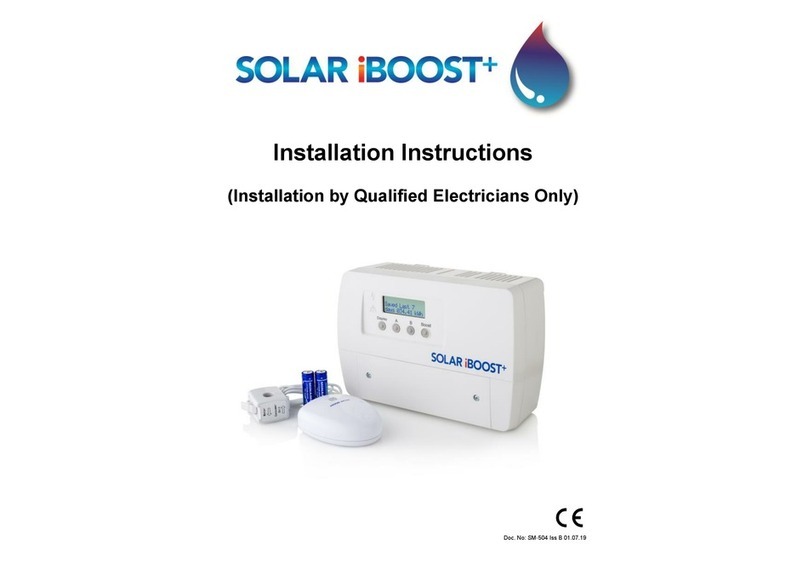
Marlec
Marlec Solar iBoost+ installation instructions
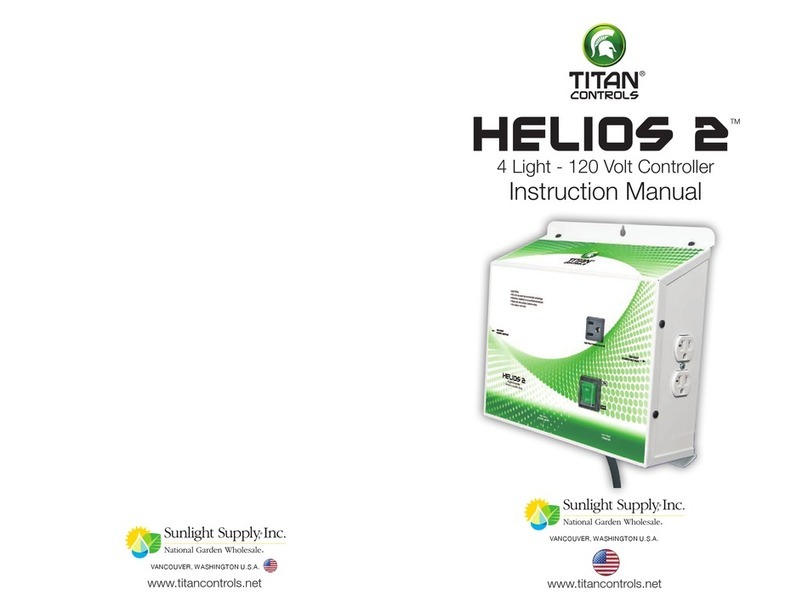
Sunlight Supply
Sunlight Supply Titan Controls Helios 2 instruction manual

Varian
Varian Turbo-V 300 ICE instruction manual
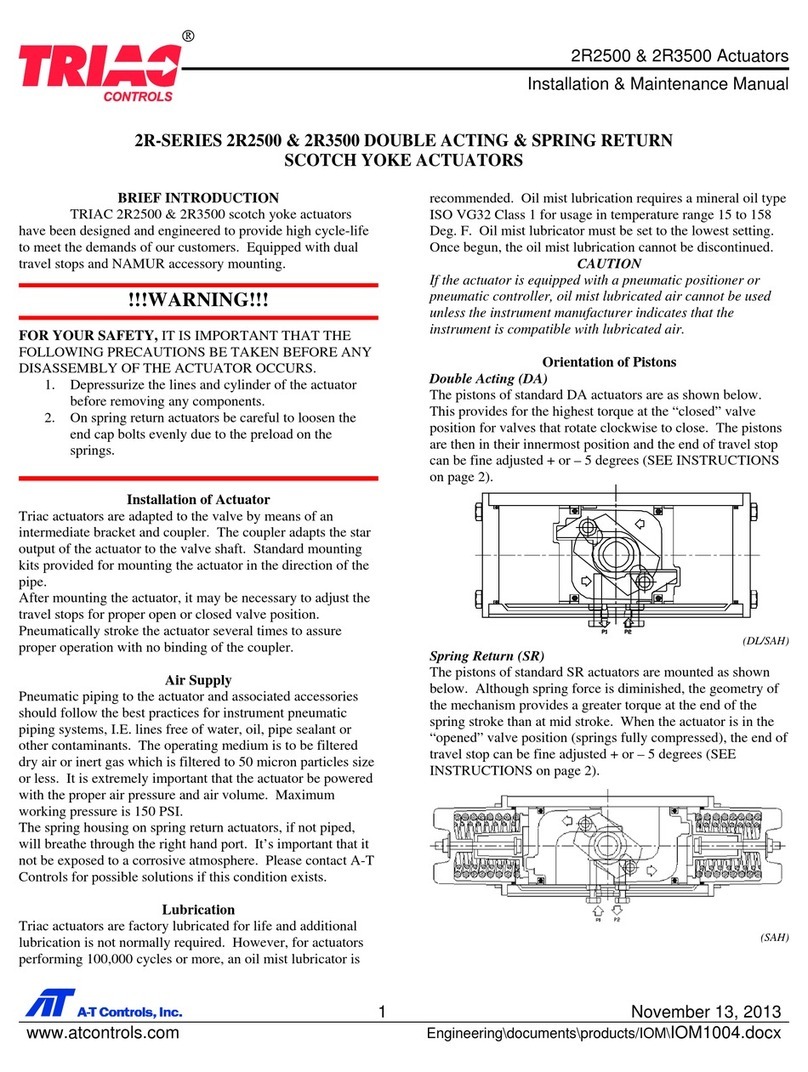
TRIAC
TRIAC 2R2500 Installation & maintenance manual
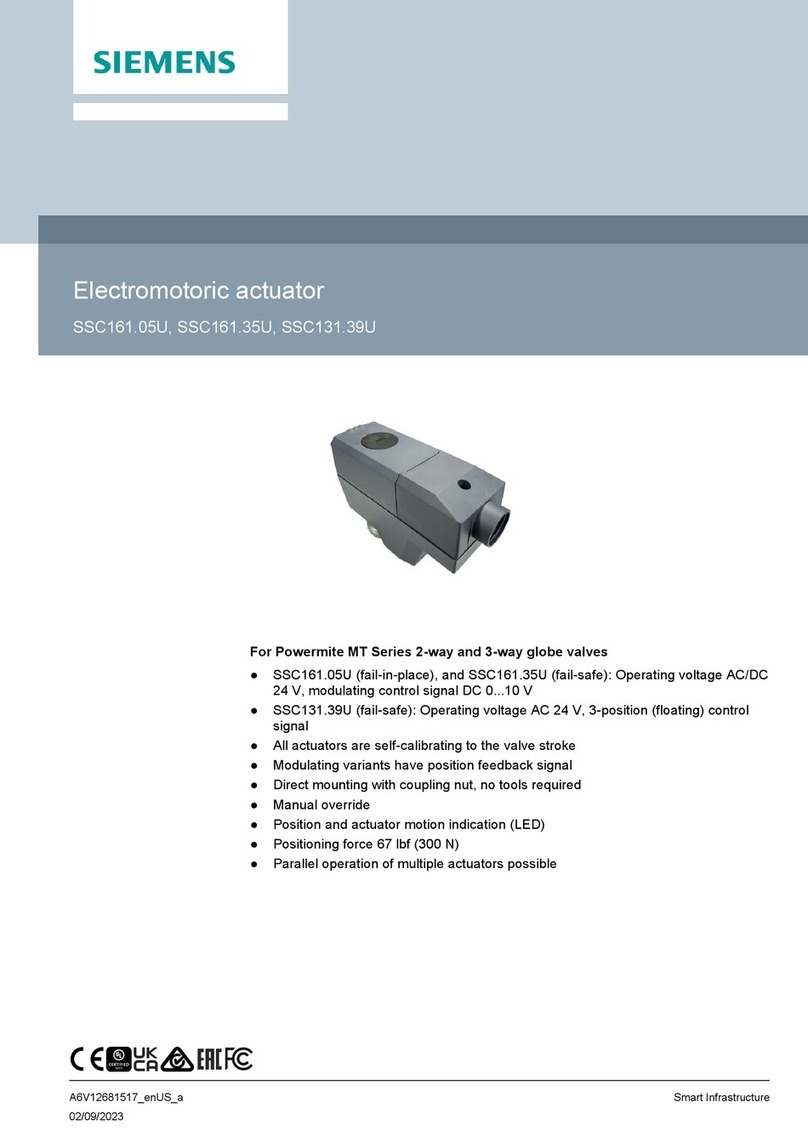
Siemens
Siemens SSC161.05U quick start guide
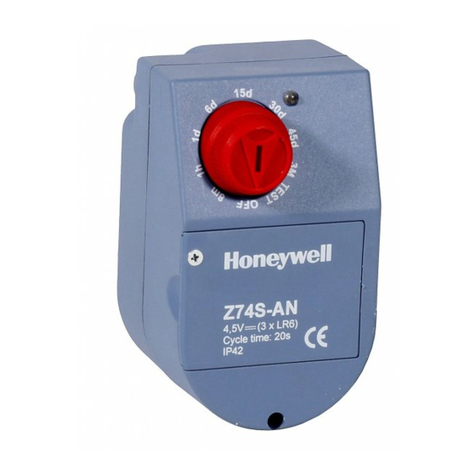
Honeywell
Honeywell Z74S-AN installation instructions
